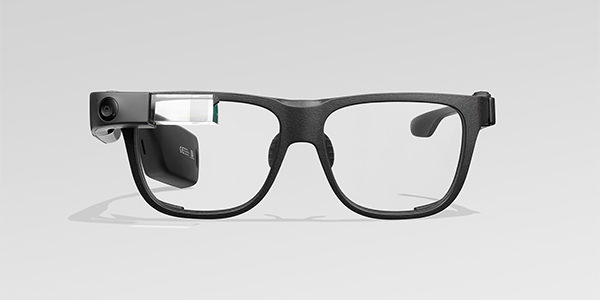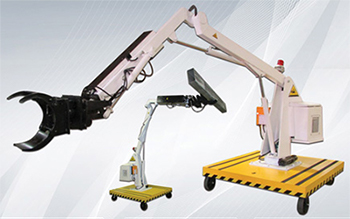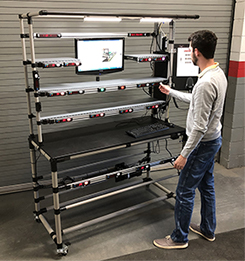Spotlight on ... mobile tech

Smart glasses for order picking: Picavi, a developer of pick-by-vision solutions for the warehouse sector, has expanded its portfolio with Glass Enterprise Edition 2, a wearable computing device for order picking (see photo above). The updated glasses come with new technical specifications. These include a Qualcomm quad-core processor and the Android 8.1 operating system, also known as Android Oreo. The new hardware makes the glasses faster and increases battery life, the manufacturer says.
The Glass Enterprise Edition 2 is also part of the Android Open Source platform, making the glasses easy to customize, the company says. (Picavi GmbH)
Cloud-based damage-monitoring solution: SpotSee, an Internet of Things end-to-end solution provider that enables customers to spot damage in their operations and see it in real time, has added temperature-threshold monitoring capabilities to its SpotBot Cellular impact-monitoring device.
With this additional information accessible anywhere through the SpotSee Cloud, users are able to ensure that temperature-sensitive items, such as food and beverage products, are not exposed to conditions that compromise quality, the company says.
SpotBot is a real-time damage-monitoring solution that helps quality, plant, and supply chain managers as well as forwarders and truckers easily see where and when impacts or temperature deviations occur and the potential severity of the damage. This allows possibly damaged shipments to be stopped and properly addressed before delivery. (SpotSee)
 Mobile crane: Material handling and automated equipment manufacturer Air Technical Industries has developed the "MIRA" (mobile industrial robotic arm) mobile crane. The robotic knuckle boom has nine axes of articulation that allow it to perform a multitude of tasks that are difficult or dangerous for humans to perform.
Mobile crane: Material handling and automated equipment manufacturer Air Technical Industries has developed the "MIRA" (mobile industrial robotic arm) mobile crane. The robotic knuckle boom has nine axes of articulation that allow it to perform a multitude of tasks that are difficult or dangerous for humans to perform.
The unit has an extended reach of 156 inches and height of 192 inches. Its functional capabilities are mobility, steering, mast rotation, main-arm lift, knuckle reach, automatic and effector leveling function, pitch, roll, and gripper. Optional attachments include a round ram for lifting coils, a scoop to pick up bulk items, and lifting forks.
MIRA is battery powered and has joystick- and pushbutton-operated radio controls. It can be equipped with a searchlight and camera so that the operator can remotely see all the tasks at hand.
The robotic arm is available in capacities of 250, 400, and 1,000 pounds and arm lengths of 96, 120, and 156 inches. (Air Technical Industries)
Mobile computer: Honeywell, a manufacturer of safety and productivity solutions, has introduced the next-generation Dolphin CT40 mobile computer, an enhanced version of its go-to mobile computing solution for retail store associates and highly mobile workers.
The computer is a full-touch device for retail, light transportation and logistics, and direct store delivery applications. The CT40 is built on Honeywell's Mobility Edge platform, which provides a unified hardware architecture and set of software tools that streamline deployment and management of mobility solutions. The scalable platform allows IT departments to develop and certify a software application a single time before deploying to enterprise mobile devices.
The new enterprise-class CT40 is now push-to-talk- and VoIP-ready, eliminating the need to have multiple devices for in-store communications and inventory management. The CT40 is an Android Enterprise Recommended device, meaning that it has been validated by a Google-led initiative that helps businesses select, deploy, and manage Android devices and services best suited to their enterprise needs.
The mobile computer can be connected to Honeywell Operational Intelligence, a cloud-based software solution that tracks, manages, and optimizes mobile computers across all locations throughout the operational lifecycle and the return-to-manufacturer authorization process. (Honeywell)
 Pick-to-light workstation: Creform Corp. has designed a new workstation that is suitable for assembly operations that require light-guide picking to control process flow and help reduce errors.
Pick-to-light workstation: Creform Corp. has designed a new workstation that is suitable for assembly operations that require light-guide picking to control process flow and help reduce errors.
Parts for an assembly operation can be presented on shelves or gravity-flow lanes above and below the work surface. Each part location features a light for guided picking. Each light features a three-digit display for quantity information as well as a pushbutton or infrared sensor for pick acknowledgment. The pick-to-light system is self-contained in the workstation and is powered by a basic PC and a controller mounted to the side of the workstation.
Picking job "recipes" are easily created and maintained using simple and easy-to-understand and -manipulate Excel templates. A recipe is initiated with a bar-code scan.
This station can be configured for a stand-up or a sit-down position. Secured to each of the workstation's four vertical legs is a hydraulic cylinder so the work surface's height can be adjusted to optimize the ergonomics for each worker.
The workstation measures 67 inches wide by 26 inches deep by 81 inches high but can be easily reconfigured to meet the client's needs, the company says. (Creform)
Related Articles
Copyright ©2024. All Rights ReservedDesign, CMS, Hosting & Web Development :: ePublishing